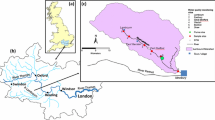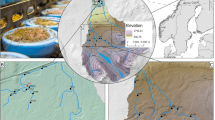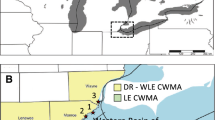Abstract
Agricultural runoff often contains pollutants with antagonistic impacts. The individual influence of nutrients and atrazine on periphyton has been extensively studied, but their impact when introduced together and with multiple agricultural pollutants is less clear. We simulated a field-scale runoff pulse into a riverine wetland that mimicked pollutant composition typical of field runoff of the Mississippi River Alluvial Plain. Periphyton biomass and functional responses were measured for 2 weeks along a 500 m section. Additionally, laboratory chamber assays were used to identify potential periphyton changes due to nutrients, atrazine, and their interactions. Generally, nutrients stimulated, and atrazine reduced chlorophyll a (Chl a) in chambers. In the wetland, nutrient and atrazine relationships with periphyton were weaker, and when found, were often opposite of trends in chambers. Total nitrogen (TN) was inversely related to Chl a, and total phosphorus was inversely related to respiration (R) rates. Atrazine (10–20 μg L−1 in the wetland) had a positive relationship with ash-free dry mass (AFDM), and weakened the relationship between TN and AFDM. Wetland periphyton biomass was better correlated to total suspended solids than nutrients or atrazine. Periphyton function was resilient as periphyton gross primary production (GPP)/R ratios were not strongly impacted by runoff. However, whole-system GPP and R decreased over the 2-week period, suggesting that although periphyton metabolism recovered quickly, whole-system metabolism took longer to recover. The individual and combined impacts of nutrients and atrazine in complex pollutant mixtures can vary substantially from their influence when introduced separately, and non-linear impacts can occur with distance downstream of the pollutant introduction point.






Similar content being viewed by others
References
APHA (2005) Standard methods for the examination of water and wastewater, 21st edn. American Public Health Association, Washington, DC
Bott TL (1996) Algae in microscopic food webs. In: Stevenson RJ, Bothwell ML, Lowe RL (eds) Algal ecology. Academic Press, San Diego, pp 574–608
Bott TL (2006) Primary productivity and community respiration. In: Hauer FR, Lamberti GA (eds) Methods in stream ecology. Elsevier, Amsterdam, pp 663–690
Burnham KP, Anderson DR (1998) Model selection and inference: a practical information—theoretic approach. Springer, New York
Cohen J (1988) Statistical power analysis for the behavioral sciences, 2nd edn. Lawrence Erlbaum, Hillsdale
Cole JJ (1982) Interactions between bacteria and algae in aquatic ecosystems. Annu Rev Ecol Evol Syst 13:291–314
Day KE (1993) Short-term effects of herbicides on primary productivity of periphyton in lotic environments. Ecotoxicology 2:123–138
DeLorenzo ME, Lauth J, Pennington PL, Scott GI, Ross PE (1999) Atrazine effects on the microbial food web in tidal creek mesocosms. Aquat Toxicol 46:241–251
DeLorenzo ME, Leatherbury M, Weiner JA, Lewitus AJ, Fulton MH (2004) Physiological factors contributing to the species-specific sensitivity of four estuarine microalgal species exposed to the herbicide atrazine. Aquat Ecosyst Health 7:137–146
Dodds WK (2003) The role of periphyton in phosphorus retention in shallow freshwater aquatic systems. J Phycol 39:840–849
Dodds WK, Beaulieu JJ, Eichmilier JJ, Fischer JR, Franssen NR, Gudder DA, Makinster AS, McCarthy MJ, Murdock JN, O’Brien JM, Tank JL, Sheibley RW (2008) Nitrogen cycling and metabolism in the thalweg of a prairie river. J Geophys Res Biogsci 113:G04029
Dunlop WP, Cortina JM, Vaslow JB, Burke MJ (1996) Meta-analysis of experiments with matched groups or repeated measures designs. Psychol Methods 1:170–177
Fairchild JF, Ruessler DS, Carlson AR (1998) Comparative sensitivity of five species of macrophytes and six species of algae to atrazine, metribuzin, alachlor, and metolachlor. Environ Toxicol Chem 17:1830–1834
Faust M, Altenburger R, Backhaus T, Blanck H, Boedeker W, Gramatica P, Hamer V, Scholze M, Vighi M, Grimme LH (2003) Joint algal toxicity of 16 dissimilarly acting chemicals is predictable by the concept of independent action. Aquat Toxicol 63:43–63
Gao JP, Maguhn J, Spitzauer P, Kettrup A (1998) Sorption of pesticides in the sediment of the Teufelsweiher Pond (Southern Germany). II: competitive adsorption, desorption of aged residues and effect of dissolved organic carbon. Water Res 32:2089–2094
Giardina MC, Giardi MT, Filacchione G (1982) Atrazine metabolism by Nocardia: elucidation of the initial pathway and synthesis of potential metabolites. Agric Biol Chem 46:1439–1445
Guasch H, Sabater S (1998) Light history influences the sensitivity to atrazine in periphytic algae. J Phycol 34:233–241
Guasch H, Munoz I, Roses N, Sabater S (1997) Changes in atrazine toxicity throughout succession of stream periphyton communities. J Appl Phycol 9:137–146
Guasch H, Ivorra N, Lehmann V, Paulsson M, Real M, Sabater S (1998) Community composition and sensitivity of periphyton to atrazine in flowing waters: the role of environmental factors. J Appl Phycol 10:203–213
Guasch H, Admiraal W, Sabater S (2003) Contrasting effects of organic and inorganic toxicants on freshwater periphyton. Aquat Toxicol 64:165–175
Guasch H, Ivorra N, Lehmann V, Van Beusekom B, Sabater S, Admiraal W (2007) Influence of phosphate on the response of periphyton to atrazine exposure. Arch Environ Contam Toxicol 52:32–37
Hamala JA, Kollig HP (1985) The effects of atrazine on periphyton communities in controlled laboratory ecosystems. Chemosphere 14:1391–1408
Hill WR, Ryon MG, Smith JG, Adams SM, Boston HL, Stewart AJ (2010) The role of periphyton in mediating the effects of pollution in a stream ecosystem. Environ Manag 45:563–576
Hoagland KD, Drenner RW, Smith JD, Cross DR (1993) Freshwater community responses to mixtures of agricultural pesticides: effects of atrazine and bifenthrin. Environ Toxicol Chem 12:627–637
Jassby AD, Platt T (1976) Mathematical formulation of relationship between photosynthesis and light for phytoplankton. Limnol Oceanogr 21:540–547
Jensen KIN, Stephenson GR, Hunt LA (1977) Detoxification of atrazine in three gramineae subfamilies. Weed Sci 25:212–220
Junghans M, Backhaus T, Faust M, Scholze M, Grimme LH (2006) Application and validation of approaches for the predictive hazard assessment of realistic pesticide mixtures. Aquat Toxicol 76:93–110
Jurgensen TA, Hoagland KD (1990) Effects of short-term pulses of atrazine on attached algal communities in a small stream. Arch Environ Contam Toxicol 19:617–623
Knauert S, Escher B, Singer H, Hollender J, Knauer K (2008) Mixture toxicity of three photosystem II inhibitors (atrazine, isoproturon, and diuron) toward photosynthesis of freshwater phytoplankton studied in outdoor mesocosms. Environ Sci Technol 42:6424–6430
Kolpin DW, Kalkhoff SJ (1993) Atrazine degradation in a small stream in Iowa. Environ Sci Technol 27:134–139
Kotrikla A, Gatidou G, Lekkas TD (1999) Toxic effects of atrazine, deethyl-atrazine, deisopropyl-atrazine, and metolachlor on Chlorella fusca var-fusca. Global Nest Int J 1:39–45
Kröger R, Lizotte RE, Shields FD, Usborne E (2012) Inundation influences on bioavailability of phosphorus in managed wetland sediments in agricultural landscapes. J Environ Qual 41:604–614
Laviale M, Morin S, Creach A (2011) Short term recovery of periphyton photosynthesis after pulse exposition to the photosystem II inhibitors atrazine and isoproturon. Chemosphere 84:731–734
Lima DL, Schneider RJ, Scherer HW, Duarte AC, Santos EB, Esteves VI (2010) Sorption–desorption behavior of atrazine on soils subjected to different organic long-term amendments. J Agric Food Chem 58:3101–3106
Lizotte RE, Shields FD, Murdock JN, Knight SS (2012a) Responses of Hyalella azteca and phytoplankton to a simulated agricultural runoff event in a managed backwater wetland. Chemosphere 87:684–691
Lizotte RE, Shields FD, Testa S (2012b) Effects of a simulated agricultural runoff event on sediment toxicity in a managed backwater wetland. Water Air Soil Pollut. doi:10.1007/s11270-012-1287-1
Lockert CK, Hoagland KD, Siegfried BD (2006) Comparative sensitivity of freshwater algae to atrazine. Bull Environ Contam Toxicol 76:73–79
Mandelbaum RT, Wackett LP, Allan DL (1993) Mineralization of the s-triazine ring of atrazine by stable bacterial mixed cultures. Appl Environ Microb 59:1695–1701
Murdock JN, Wetzel DL (2012) Macromolecular response of individual algal cells to nutrient and atrazine mixtures within biofilms. Microb Ecol 63:761–772
Naegeli MW, Uehlinger U (1997) Contribution of the hyporheic zone to ecosystem metabolism in a prealpine gravel-bed river. J N Am Benthol Soc 16:794–804
O’Brien JM, Dodds WK, Wilson KC, Murdock JN, Eichmiller J (2007) The saturation of N cycling in Central Plains streams: N-15 experiments across a broad gradient of nitrate concentrations. Biogeochemistry 84:31–49
Pannard A, Le Rouzic B, Binet F (2009) Response of phytoplankton community to low-dose atrazine exposure combined with phosphorus fluctuations. Arch Environ Contam Toxicol 57:50–59
Pinckney JL, Ornolfsdottir EB, Lumsden SE (2002) Estuarine phytoplankton group-specific responses to sublethal concentrations of the agricultural herbicide, atrazine. Mar Pollut Bull 44:1109–1116
Pratt JR, Melendez AE, Barreiro R, Bowers NJ (1997) Predicting the ecological effects of herbicides. Ecol Appl 7:1117–1124
Radosevich M, Traina SJ, Hao YL, Tuovinen OL (1995) Degradation and mineralization of atrazine by a soil bacterial isolate. Appl Environ Microb 61:297–302
Rebich RA (2001) Quality of runoff in the Mississippi Delta Management Systems Evaluation Areas project, 1996–1999. In: Rebich RA, Knight SS (eds) The Mississippi Delta Management Systems Evaluation Areas project, 1996–1999. Mississippi State University Information Bulletin 377, pp 154–168
Relyea RA (2009) A cocktail of contaminants: how mixtures of pesticides at low concentrations affect aquatic communities. Oecologia 159:363–376
Riley AJ (2011) Effects of riparian woody vegetation encroachment on prairie stream structure and function with emphasis on whole-stream metabolism. PhD dissertation, Kansas State University, Manhattan
Rohr JR, Schotthoefer AM, Raffel TR, Carrick HJ, Halstead N, Hoverman JT, Johnson CM, Johnson LB, Lieske C, Piwoni MD, Schoff PK, Beasley VR (2008) Agrochemicals increase trematode infections in a declining amphibian species. Nature 455:1235–1239
Roman AM, Sabater S (1999) Effect of primary producers on the heterotrophic metabolism of a stream biofilm. Freshw Biol 41:729–736
Sartory DP, Grobbelaar JU (1984) Extraction of chlorophyll-a from fresh-water phytoplankton for spectrophotometric analysis. Hydrobiologia 114:177–187
Shabana EF (1987) Use of batch assays to assess the toxicity of atrazine to some selected cyanobacteria. I. Influence of atrazine on the growth, pigmentation and carbohydrate contents of Aulosira fertilissima, Anabaena oryzae, Nostoc muscorum and Tolypothrix tenuis. J Basic Microb 27:113–119
Shields FD, Pearce CW (2010) Control of agricultural nonpoint source pollution by natural wetland management. J Environ Eng 4:62–70
Shields FD, Lizotte RE, Knight SS (2012) Spatial and temporal water quality variability in aquatic habitats of a cultivated floodplain. River Res Appl. doi:10.1002/rra.1596
Smith S, Cooper CM, Lizotte RE (2007) Pesticides in shallow ground water in the forested natural wetland riparian area of the Beasley Lake Watershed, Mississippi, USA, 2001–2005. Int J Ecol Environ Sci 33:223–231
Solomon KR, Baker DB, Richards RP, Dixon DR, Klaine SJ, LaPoint TW, Kendall RJ, Weisskopf CP, Giddings JM, Giesy JP, Hall LW, Williams WM (1996) Ecological risk assessment of atrazine in North American surface waters. Environ Toxicol Chem 15:31–74
Steinman AD, Lamberti GA, Leavitt PR (2006) Biomass and pigments of benthic algae. In: Hauer FR, Lamberti GA (eds) Methods in stream ecology. Elsevier, Amsterdam, pp 357–379
Tang JX, Hoagland KD, Siegfried BD (1997) Differential toxicity of atrazine to selected freshwater algae. Bull Environ Contam Toxicol 59:631–637
Tang J, Hoagland KD, Siegfried BD (1998) Uptake and bioconcentration of atrazine by selected freshwater algae. Environ Toxicol Chem 17:1085–1090
Tlili A, Montuelle B, Berard A, Bouchez A (2011) Impact of chronic and acute pesticide exposures on periphyton communities. Sci Tot Environ 409:2102–2113
Vallotton N, Moser D, Eggen R, Junghans M, Chèvre N (2008) S-metolachlor pulse exposure on the alga Scenedesmus vacuolatus: effects during exposure and the subsequent recovery. Chemosphere 73:395–400
Voets JP, Meerschman P, Verstraete W (1974) Soil microbiological and biochemical effects of long-term atrazine applications. Soil Biol Biochem 6:149–152
Wackett L, Sadowsky M, Martinez B, Shapir N (2002) Biodegradation of atrazine and related s-triazine compounds: from enzymes to field studies. Appl Microb Biotechnol 58:39–45
Weiner JA, DeLorenzo ME, Fulton MH (2004) Relationship between uptake capacity and differential toxicity of the herbicide atrazine in selected microalgal species. Aquat Toxicol 68:121–128
Weiner JA, DeLorenzo ME, Fulton MH (2007) Atrazine induced species-specific alterations in the subcellular content of microalgal cells. Pestic Biochem Phys 87:47–53
Zheng SQ, Cooper JF (1996) Adsorption, desorption and degradation of three pesticides in different soils. Arch Environ Contam Toxicol 30:15–20
Acknowledgments
We thank Alexandra Ashmead, Lisa Brooks, Daniel Warren, and John Massey for field and laboratory assistance. Matt Moore and Traci Hudson provided insightful comments on this manuscript. This work was completed as part of the research program of the Water Quality and Ecology Research Unit of the USDA Agricultural Research Service.
Conflict of interest
All authors confirm that there are no conflicts of interests. The experiments comply with the current laws of the country in which they were performed.
Author information
Authors and Affiliations
Corresponding author
Rights and permissions
About this article
Cite this article
Murdock, J.N., Shields, F.D. & Lizotte, R.E. Periphyton responses to nutrient and atrazine mixtures introduced through agricultural runoff. Ecotoxicology 22, 215–230 (2013). https://doi.org/10.1007/s10646-012-1018-9
Accepted:
Published:
Issue Date:
DOI: https://doi.org/10.1007/s10646-012-1018-9




